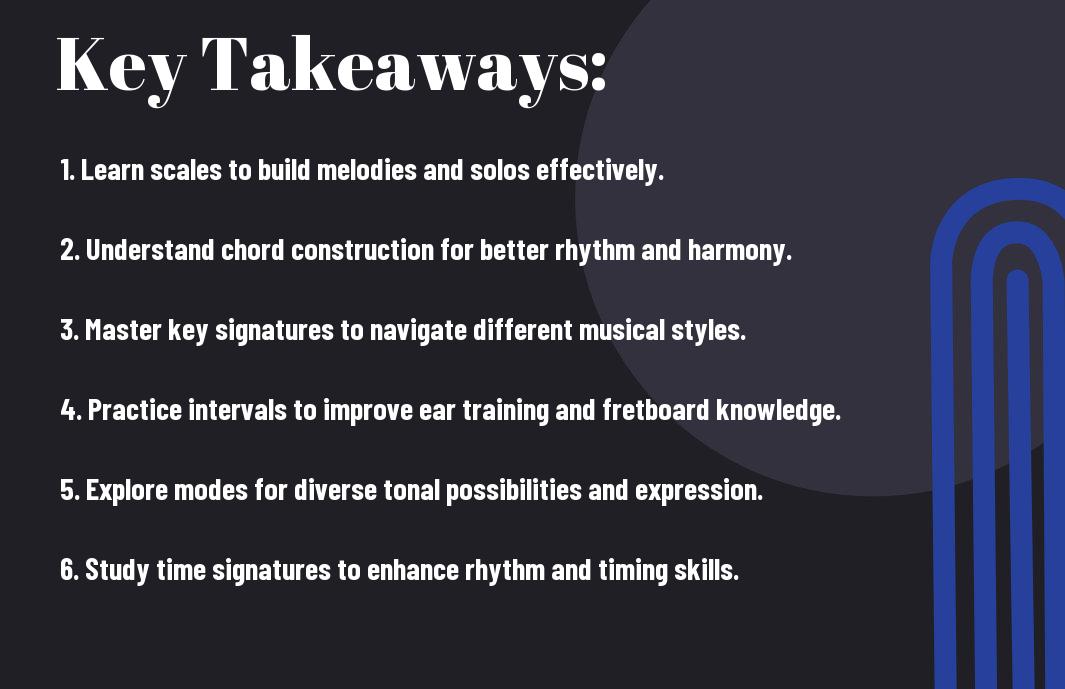


You may think music theory is only for composers or pianists, but as a guitarist, understanding it can significantly enhance your playing and creativity. Learning the basics of music theory, such as scales, chords, and rhythm, will empower you to construct your own solos and progressions. You’ll find that incorporating these concepts into your practice not only makes you a more versatile musician but also deepens your appreciation for the music you love. Join me as we explore how music theory can transform your guitar journey!

Decoding the Fingerboard: Navigating the Guitar Neck
Understanding the layout of the guitar neck and how to effectively navigate it can unlock new potentials in your playing. Think of the fingerboard as a map; every fret, note, and interval has a purpose, allowing you to explore different musical landscapes. By mastering these concepts, you not only enhance your creativity but also develop your overall musicianship, making your guitar journey more rewarding.
The Fretboard Layout: Notes and Intervals
The fretboard is divided into half steps, with each fret representing a semitone. Starting from the open strings E, A, D, G, B, and e, every fret you move up increases the pitch of the note. Learning the natural notes and their sharps/flats on the fretboard is important for skillful improvisation and composition. Visualizing intervals—like thirds and fifths—helps you see how notes relate, serving as a foundation for your playing ability.
Chord Construction: Major, Minor, and Beyond
Building chords on the guitar involves understanding both the notes that make them up and their emotional qualities. Major chords are constructed with a root, major third, and perfect fifth, which create a bright and uplifting sound. Conversely, minor chords change that third to a flat, delivering a more pensive tone. As you probe deeper, extensions like seventh chords and augmented variations add richness and complexity to your progressions, allowing for more expressive songwriting.
Getting familiar with chord construction opens up a world of musical possibilities. For instance, the major scale consists of seven notes, and each can serve as a root for its respective major or minor chord. By applying various voicings and inversions, you can create lush harmonic textures. To illustrate, take the C major chord (C, E, G); by forming a Cmaj7 (C, E, G, B), you introduce an added layer that brings sophistication to your sound. Experimenting with these structures enhances your proficiency, letting you move freely between different styles and genres. Ultimately, knowledge of chord construction is a key asset in your arsenal as a guitarist.
The Language of Music: Scales and Modes for Guitarists
Understanding scales and modes is akin to learning the vocabulary and grammar of music. For guitarists, these foundational elements provide the framework to create melodies, harmonies, and improvisations. By mastering scales and their associated modes, you can enhance your musical expression and unlock a world of creative possibilities, picking the ideal tools to craft your sound and style.
Essential Scales: Major, Minor, and Pentatonic
The major, minor, and pentatonic scales form the cornerstone of guitar music. The major scale exudes a bright, happy sound, while the minor scale evokes emotions ranging from melancholy to tension. The pentatonic scale, with its five notes, simplifies your improvisation and offers a perfect foundation for blues and rock genres. Familiarizing yourself with these scales will allow you to navigate your fretboard with ease, making your playing more intuitive and expressive.
Exploring Modes: Unlocking New Melodic Possibilities
Exploring modes opens up a diverse musical palette, allowing you to access various emotional landscapes. The seven modes derived from the major scale each possess distinct tonal qualities. For instance, the Dorian mode has a jazzy feel, while the Mixolydian mode brings a more bluesy and rock-oriented sound. By experimenting with different modes, you can greatly enrich your playing, adding depth and variety to your improvisation and composition.
Diving deeper into modes reveals their unique characteristics and how they can transform your musical approach. The Ionian mode serves as your basic major scale, characterized by its happy sound, while the Phrygian mode introduces a more exotic, almost Spanish flavor. Each mode has its own set of intervals, making them suitable for different genres and settings. For instance, if you’re looking to write something with an ethereal quality, try using the Lydian mode—its raised fourth creates a dreamy effect. By practicing these modes across the fretboard, you’ll find yourself not only improvising more freely but also composing with newfound inspiration and creativity.
Rhythm and Timing: The Backbone of Guitar Playing
Mastering rhythm and timing is vital for every guitarist. It serves as the foundation upon which you build your musical ideas. A strong sense of rhythm enables you to play in sync with other musicians and gives your guitar playing a dynamic and engaging feel. Whether you’re strumming chords or performing intricate solos, achieving a solid rhythmic foundation will elevate your performances to new heights.
Understanding Time Signatures and Rhythmic Patterns
Time signatures dictate the number of beats in each measure and define how rhythms are structured. Common signatures like 4/4 and 3/4 provide the framework for countless songs. I often analyze rhythmic patterns within these frameworks to create unique strumming or picking styles. By breaking down popular songs into their time signatures, I can better understand how to incorporate varied rhythms into my playing, enhancing my overall musical expression.
Syncopation and Groove: Enhancing Your Guitar Style
Syncopation introduces unexpected accents to your playing, creating a sense of groove that captivates listeners. Exploring syncopated rhythms can transform your guitar solos and rhythm parts, adding an element of surprise and drive. By playing off the established beat, I’ve been able to create distinctive guitar lines that resonate well with various musical genres.
Delving deeper into syncopation reveals its power to reshape how you approach the guitar. For instance, I often find myself playing off-beat notes or emphasizing weak beats to craft fresh, exciting grooves. Think of classic funk riffs where syncopation is key; guitars cut through the mix with their rhythmic accents, invigorating the entire band. Incorporating syncopation doesn’t merely make your playing stand out; it enhances your ability to connect with dances, audiences, and even your own emotional expression while jamming or performing. Embracing groove-oriented practices holds the potential to significantly enrich your guitar style and overall musicianship.
Applying Harmony: Chord Progressions that Resonate
Exploring chord progressions is where the magic of harmony occurs. As you play your guitar, you’ll find that certain combinations of chords create an emotional impact that resonates deeply with both you and your listeners. To further grasp these concepts, I recommend checking out the MusicTheoryForGuitar channel for visual aids and demonstrations. With practice, you’ll gain the ability to craft engaging progressions that elevate your playing and songwriting skills.
The Power of Common Progressions: I-IV-V and Beyond
The I-IV-V progression is a quintnecessary building block of Western music. This sequence forms the backbone of countless songs across genres, providing a strong sense of resolution and familiarity. You can expand from this foundation by incorporating variations like I-vi-IV-V or exploring modal progressions to add complexity. Each variation alters the emotional landscape of your music, allowing you to express different feelings through familiar chord patterns.
Borrowed Chords and Modal Interchange: Expanding Your Palette
Borrowed chords and modal interchange offer a captivating way to enrich your chord progressions. By borrowing chords from parallel modes, you introduce unexpected colors to your music. For instance, if you’re in a major key, you might borrow the iv chord from its minor counterpart. This approach can create evocative moments within your songs, surprising listeners and deepening their emotional connection. By using borrowed chords effectively, you not only diversify your repertoire but also unlock new creative possibilities.
Incorporating borrowed chords often means stepping outside the traditional major and minor frameworks. For example, if I’m working in C Major, the iv chord from C minor (Fm) adds a poignant twist. I might transition smoothly from C to Fm, evoking a sense of longing or nostalgia. Similarly, utilizing modal interchange, such as drawing from C Mixolydian or C Dorian, can bring unique flavors to your progressions, keeping your compositions fresh and innovative. Playing around with these techniques can turn a straightforward progression into a rich tapestry of harmonies that captivates your audience.
The Emotional Palette: Using Dynamics and Articulation
Every note you play on the guitar carries an emotional weight, and utilizing dynamics and articulation is key to expressing that. The subtle variations in volume and intensity can transform a simple melody into a poignant narrative. By adjusting how hard or soft you play, as well as the way you articulate notes, you can evoke a wide spectrum of feelings, from joy to melancholy. Incorporating these elements into your playing allows your audience to connect on a deeper level, making the music undeniably more powerful and engaging.
Expressive Techniques: Hammer-ons, Pull-offs, and Slides
Incorporating hammer-ons, pull-offs, and slides into your guitar playing can significantly enhance your expressiveness. These techniques create fluid transitions between notes, allowing you to articulate musical phrases with a natural, singing quality. For instance, a hammer-on adds a sudden burst of energy, while a pull-off can provide a gentle release. Additionally, slides can gracefully connect distant notes, making your melodic lines smoother. By mastering these expressive techniques, you can infuse your playing with more emotion and character.
The Role of Dynamics: Making Your Playing Communicative
Dynamics serve as the emotional light and shade in your music. Varying your volume not only highlights key moments in a piece but also draws listeners into the narrative you’re creating with your guitar. A whispered passage can signal intimacy, while a climactic roar can convey urgency or triumph. I find that using a mix of loud and soft passages keeps the audience engaged, much like a storyteller varies their tone to maintain interest. By taking advantage of dynamics, you invite your listeners to experience the highs and lows of the musical journey you’re crafting.
When you consciously manipulate dynamics, think about how changes in volume can mimic conversational nuances. For example, playing softly during reflective moments invites the audience to listen closely, while rising to a crescendo during more intense sections evokes excitement and energy. In practice, try experimenting with different volume levels, even within a single phrase; alternating between piano (soft) and forte (loud) can bring your playing to life. Use dynamics not only to express the written notes but to imprint your unique emotional fingerprint onto the music.
Final Words
From above, I hope to have opened your eyes to the profound impact that music theory can have on your guitar playing. By understanding the structure and principles behind music, you can elevate your skills, enhance your creativity, and improve your overall musicianship. As you continue seeking knowledge, I encourage you to explore these concepts further and apply them to your practice. Your journey in mastering the guitar will be much more rewarding as you weave theory into your playing style.


